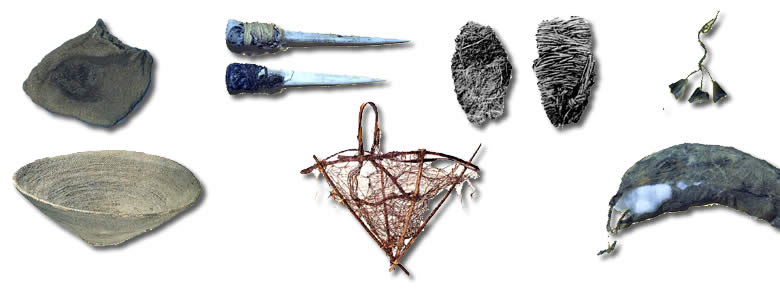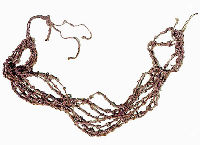
Knotted cording, such as this, once
held clumps of split feathers in each knot, creating
a sort of "plumed boa" perhaps worn during
ceremonies. Some of the cordage has been dyed red with
ocher (Burial 4).
|
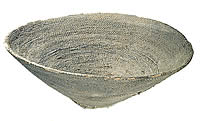
A large coiled basket constructed
with narrow leaf yucca leaves has a thin coating of
clay on the interior and was probably used for parching
seeds. It was inverted over two infant burials in two
grass bags (Burials 2 and 3).
|
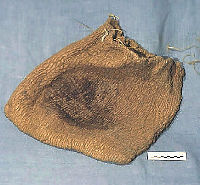
A twined grass bag which contained
a child (Burial 4). These distinctive bags, found only
in two other Rustler Hills sites, were used for a variety
of functions.
|
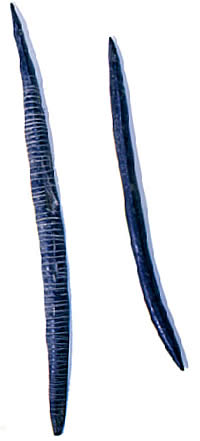
A notched rhythm
stick (left) and the sounding stick
used to play it.
|
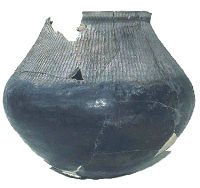
A Mata Red-on Brown Textured jar
was ceremonially "killed" and the sherds arranged over
a coiled, parching basket that was inverted over two
infant burials (Burials 2 and 3).
|
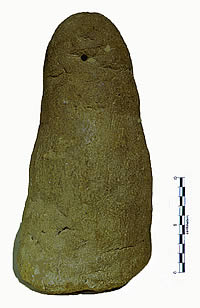
This limonite cone with a small opening
at the top and the rhythm stick (described above) were
placed near an adult male burial (Burial 6) and may
have served a ceremonial purpose.
|
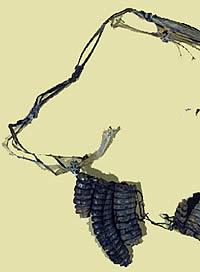
This rattle was made by securing
the tail of a rattlesnake onto a stick with sinew and
attaching 26 more rattlers (Burial 1). In the center
are three rattlesnake fangs and the skin from the lower
jaw of a snake, probably a rattlesnake. Click to enlarge.
|
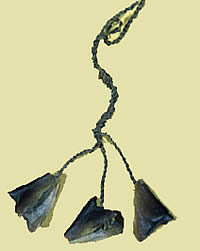
Deer-hoof tinklers
found with a child burial (Burial 1).
|
|
Archeologists uncovered a fascinating array
of artifacts in Granado Cave, including intricate perishable
items woven of plant fibers, chipped stone tools, and pottery.
These materials, some mundane, others perhaps related to ceremonies
and rituals—including burials— tell of a skilled,
industrious, and caring people who were well-adapted to the
harsh terrain and who knew how to make the most of the comparatively
scant resources. Conservative hunter-gatherers, they used
reliable materials and established construction techniques
that had been tried and proven over centuries of use.
In the section below, we present a gallery of
representative artifacts. Some, such as fiber sandals and
the distinctive carrying baskets known as kiâhâs,
were so well preserved that they could be interpretively reconstructed
to learn more about the technology (see Reconstructing
Sandals and Reconstructing
a Kiâhâ sections).
Cordage and Cotton
The procurement of materials for producing
cordage, the processing of the fiber, and the twisting of
the fiber into one, two or even three plies, must have been
one of the most time-consuming tasks among the inhabitants
of Granado Cave. Large quantities of cordage were needed to
make the carrying baskets, mats, bags and other objects recovered
from the site. The cordage was typically manufactured from
narrow-leaf yucca fibers, although some is made from agave
fiber or cotton. The fiber from yucca can be extracted by
pulling the leaves from the plant and then scraping them,
or by steaming or boiling them.
The presence of cotton cordage is interesting
since cotton was not grown locally. It is one indication of
trade and other contacts with agriculturalists to the north,
west, or southwest. On the basis of other trade items found
at Granado—pottery and shells—the source of the
cotton is most likely either the villages to the west on the
Rio Grande or in northern Chihuahua. The radiocarbon dates
associated with the cotton artifacts are the earliest dates
for cotton in Texas.
Basketry
Basketry from Granado Cave shows influence of
traits from the Pueblo areas to the north, the various groups
around El Paso, and other hunting and gathering groups from
the region. However, some techniques may be unique to the
Rustler Hills. Two cord-mesh carrying baskets, known as kiâhâs,
and several coiled parching basket fragments were recovered.
The latter types had a thin layer of fine mud/clay to keep
the surface from charring when parching seeds.
In order to better understand
the process of their construction, a small kiâhâ
was reconstructed.
Matting, Bags and Sandals
Fragments of matting, woven sandals, whole burial
bags, and other plaited and twined items were recovered from
the cave. They are comparable in terms of materials and construction
techniques to those from other areas of the Trans-Pecos region
and the Southwest in general. An important exception is the
distinctive "Rustler Hills Twined Grass Bag," a
type found as yet only in three caves: Caldwell Shelter No.
1, Brooks Cave, and Granado Cave. Made of twined coils of
retted fiber, the bags had many uses ranging from seed storage,
to carrying pouches, to burial containers.
Wood Artifacts
There is a general lack of wood
artifacts from the excavated cave sites of
the Rustler Hills. The most common wood artifacts
found in the area are throwing sticks, commonly
called "rabbit sticks." Cane arrows
with wooden foreshafts, and decorated split
agave flower stalks have also been recovered.
At Granado Cave, broken rabbit sticks were
the most common wood artifacts recovered.
A notched rhythm stick and its sounding stick
were also found, as well as broken arrows
shafts.
Pottery
There is no evidence that pottery
was produced in the Rustler Hills. The small
quantities found in the area are of types
originating in the Casas Grandes area, located
to the southwest; in the agricultural villages
around El Paso to the west; and the Pueblo
groups to the north. The source of the more
common brown ware type is more difficult to
determine, but is known to have been made
both in the scattered pithouse villages of
Southeast New Mexico and the adjacent area
of Texas. One Mata Red-on-Brown Textured jar
and 21 sherds were recovered from the excavations
at Granado Cave. The jar was covered with
soot, showing that it was used for cooking.
It had been repaired with cordage and resin-coated
grass patches several times.
Lithics
The chipped stone assemblage recovered from
Granado Cave was sorted and classified on the basis of the
reduction technology displayed by each artifact. The collection
was very meager and included water worn nodules; cores; flake
tools; modified flakes; utilized sequent flakes; chert agave/sotol
knives; utilized flakes; unifaces; drills/perforators; along
with a few arrow points, dart points, and bifaces. The finding
of agave/sotol knives attests to the importance of plant processing
at the site, as evidenced also by the three earth ovens (circular
burned rock middens) found near the front of the cave.
Other Artifacts
Other recovered items include
a number of possible ceremonial items, such
as an unusual cone made of limonite, two unfired
red clay balls, a rattlesnake-rattler rattle,
and a deer-hoof tinkler. Several of these
items are unique to Granado Cave, and their
function is not understood.
Numerous pieces of tanned skin
showing unusual skinning techniques that left
the skin tubular were also found; they were
probably tanned with a paste made of brain
tissue. A unique bird-head skin is believed
to be from a waterfowl, possibly a goose.
Only four bone tools were present
in Granado Cave, three of which were placed
with Burial 1. In addition to two bone awls,
a weaving tool made from a deer rib was identified.
Beads made from shell or plant
seeds were found in association with four
of the burials. The shells were from the Pacific
Ocean and Gulf of California, reflecting the
extent of trade networks. At least 35 feather
quills were found in association with Burial
1.
A single piece of desiccated
fruit was identified using an X-ray, which
revealed seeds consistent with the fleshy
capsules of Torrey yucca. Such capsules are
known to have been consumed for food. A bottle
gourd stained dark red with hematite was also
recovered.
|
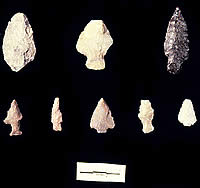
Chipped stone weaponry of the Rustler
Hills peoples. Top, dart points; bottom, arrow points.
Click images to enlarge
|
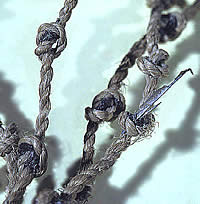
This yucca cordage still contains
pieces of split feathers held in the knots (Burial 4).
Click to enlarge.
|
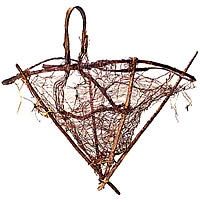
A large carrying
basket found ceremonially "killed" over
Burial 1.
|
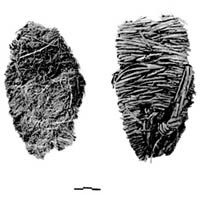
Bottom and top surfaces of two Yucca
elata sandals worn by a child. Click to see full image.
|
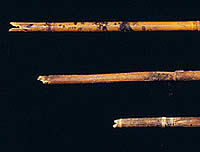
Arrows found in the cave. Top to
bottom, a wooden foreshaft, two cane arrows with sharpened
foreshafts, cane arrow with nock formed by a hardwood
plug inserted in the cane, and remnants of three-feather
fletching, all secured with sinew. Click to enlarge.
|
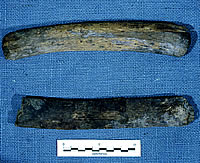
Broken rabbit sticks
found near Burial 6.
|
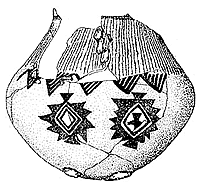
The jar is decorated
with a red band and a white wash on
the vertical corrugation of the neck,
and 19 red triangles, two Chupicuaro
diamonds and an engraved design on the
body.
|
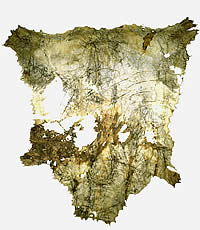
This tanned deerskin
was wrapped around the body of a child
(Burial 1).
|
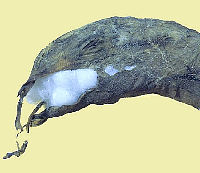
This bird-head skin
was also found with Burial 1.
|
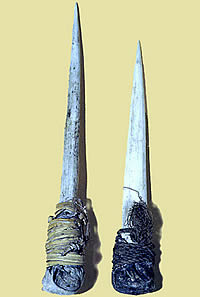
Bone awls made from
deer metapodials were probably used
to make coiled baskets (Burial 1).
|
|
